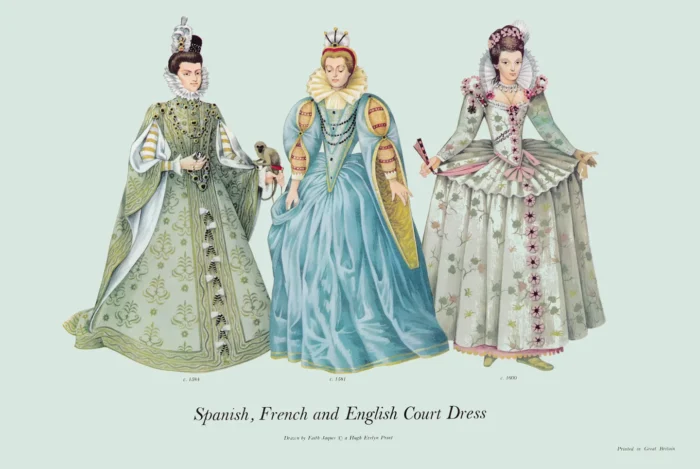Spanish, French and English Court Dress, 1581-1600
Original price was: £20.00.£15.00Current price is: £15.00.
History of Costume III 1500-1660
In stock
- Satisfaction Guaranteed
- No Hassle Refunds (see Shipping and returns)
- Secure Payments
Description
These women represent the difference in appearance and the balance of power between the nations and the sexes in the last years of the 16th century. Spain’s destiny is heralded in the rigid look of the Infanta wearing the coat-dress that was the standard pattern early in the century and remained changeless until the next. The French princess symbolizes the originality and distinction of her country. The lady of the Court of Queen Elizabeth is an example of self-assertion. France had an indigenous fountain of originality in the arts and with the conjunction of the right personalities she became the object of envy and imitation. The self-assurance of the young English woman reflects the new spirit of a nation. The costumes also reflect the status of women. Through their brains and initiative they emerged from obscurity and become leaders of men. The rigidity of Spanish clothes was part of a defensive armour. No wrinkle could mar the smooth line of mantle that accentuated the line from chin to hem. Obsolete bell-shaped sleeves were retained and fell away into the train of the mantle to emphasize the cone-shape of the figure. As skirts became wider the hair became more important and rose higher centrally, to become the apex of a triangle. Hair becomes fussy and out of proportion to the figure as costume design degenerates. Men’s hats with high crowns were a means of adding height and, trimmed with an aigrette and jewelled pin, gave a jaunty finish to an otherwise severe outfit. Masculine styles popular, from the hat to the jerkin and gloves, and from the waist upwards, a Spanish princess might be taken for a boy. She keeps her chin up on a stiff ruff reinforced by a high collar. This style marks the beginning of declining Spanish influence. The French never disguised sex and if their women adopted male styles it was coquettishly to accentuate the difference. The French court was rich in brilliant women. The Queen Mother, Catherine de Medici, set a standard of chic followed by her daughter, Marguerite de Vaudémont. This princess was the epitome of femininity. Her mother had brought many of the arts from Italy, among them the very fine lace for collars and cuffs. It was to this earlier fashion that Marguerite reverted by parting her ruff in the middle allowing it to fall back from under the chin. When it rose from the opening of the bodice in a wide fan shape it became the true Medici collar. These collars, or ‘˜whisks’, held out by wire, had extra support from a high-backed collar-band to make them tip up behind the head. The French dress was softer and more rounded than the Spanish or English. The stomacher descended into a sharp point, below the waist, and the side seams were decorated to accentuate the long line from which the skirt billowed out in large folds, unlike the Spanish flat, gored skirt. Crescent-shaped bolster pads were worn on the hips and tied in front, to lift the folds straight out from the waist. The French did eventually wear the drum-farthingale hoop, but under the skirt which softened the outline. The whole silhouette was inflated except for the ant-like waist. It is to the English that the drum-farthingale is attributed, and the Queen was wearing herself it in the 1580s. Being small and insignificant personally, the inflated costume helped to make her presence felt. The stiff and padded costume is an example of the contradictory come-hither don’t-touch principle of feminine psychology especially in England, the reinforcement of the skirt keeping pace with the undressing of the upper part of the bodice. The drum-farthingale was made differently from the other variations under the same term. A straight skirt was gathered, or pleated, round a circular piece of material that had been stiffened at the edge by a wooden hoop. A hole was cut for the waist, rather nearer to the front, in this circular top which was taped up tightly to the figure. A long basque attached to the bodice then covered the flat top in fluted folds. It may have been the emancipation of the age that shortened the skirts and rebelled against hot padding round the hips. The drum-farthingale is certainly lighter to wear and quite jaunty when tilted skilfully to show the edge of a petticoat.
Additional information
| Dimensions | 38.1 × 25.5 cm |
|---|

 English Upper-Class Dress, 1628-1634
English Upper-Class Dress, 1628-1634 


